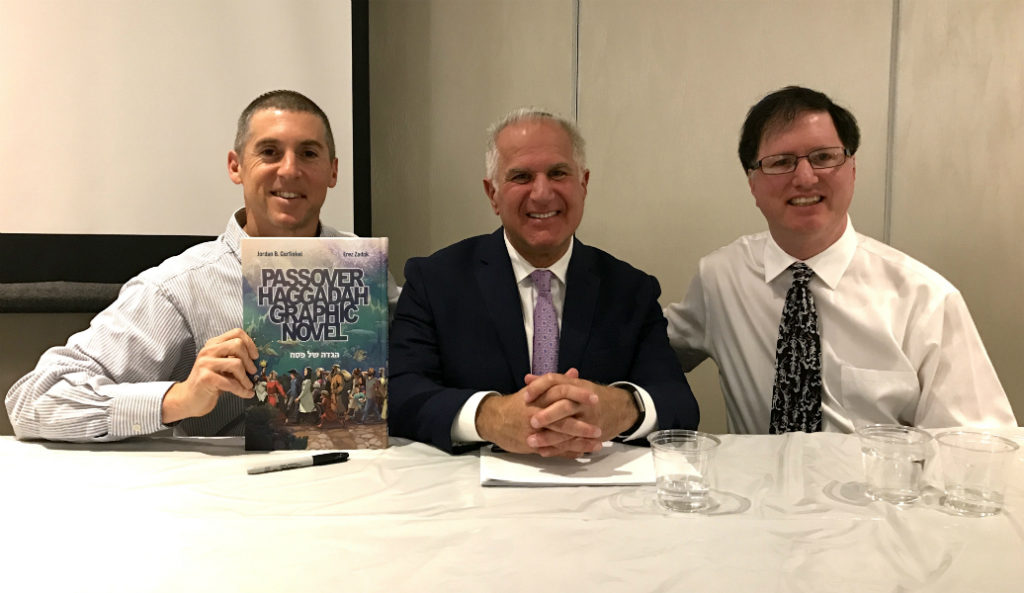The Jewish people are often referred to as the people of the Book, but it turns out they are also the people of the comic book.
Some of the comic books created by American Jews played an important role in the anti-Nazi propaganda campaign during the 1930s and ’40s, according to comic book collector Gerald Hartman.
He participated in a panel discussion that examined the Jewish people’s historic and current influence on comic book lore and graphic novels. The event, which was moderated by Rabbi Daniel Korobkin, was held at the Beth Avraham Yoseph of Toronto Congregation (BAYT) on Feb. 23.
The other panelists were Steven Bergson, the editor of the Jewish Comix Anthology, and Jordan Gorfinkel, a veteran a newspaper cartoonist and comic book editor based in Cleveland. The discussion was part of a series of events revolving around Gorfinkel – or Gorf, as he is known – who was the BAYT’s Shabbat scholar in residence.

Each panellist presented on a different aspect of comic books. Hartman spoke about the anti-Nazi bent of Jewish-owned comic books. Bergson focused on Orthodox comics and cartoonists, while Gorfinkel talked about his history with DC Comics and his latest project, The Passover Haggadah Graphic Novel.
READ: GRAPHIC NOVEL BRINGS THE PASSOVER HAGGADAH TO LIFE
Hartman said that as a child of Holocaust survivors, he became very interested in comics from the Second World War era and has amassed one of the largest collections of propaganda comics and cartoons from that period.
He said that American Jews – who were running the comic book industry during ’30s and ’40s – contributed to the war effort by countering Nazism through their publications “They were very impactful in influencing the Americans’ entry into the war.”
He noted that those comics had very provocative covers, such as Adolf Hitler holding a skull, or Captain America punching Hitler in the face. Hartman showed numerous examples of how superheroes were shown fighting Hitler and the Nazis long before the United States joined the war effort.
Hitler and his allies became the new arch-villains, he explained, as publishers felt “a need to protect the American way of life.” The publishers and artists were also very upset by the Nazis’ treatment of the Jews in Europe. “The comic books became an outlet for revenge fantasies.”
Captain America was introduced in 1941 and his alter-ego, Steve Rogers, was “the antithesis of the Aryan uber mensch (superman),” Hartman said, noting that Rogers was conceived in the Jewish image: he was an 89-lb “bookish weakling” who lived in the lower East Side of New York City.
Following the bombing of Pearl Harbor in 1941, the Japanese prime minister, Hideki Tojo, joined Hitler as an arch-villain on comic book covers. However, Hartman pointed out that the portrayal of Tojo was very racist: he was drawn with fangs, claws and a tail.
Bergson, the author and editor of the Jewish Comix Anthology series, bemoaned the lack of Orthodox Jewish comics. The late Moshe Yess was the only Canadian-Jewish Orthodox comic artist he could find.
He mentioned several American comic book artists who are Orthodox Jews. Howard Spielman created serialized comic strips about rabbis, King Solomon, ancient Israel and the legendary Golem in the Jewish Press. Neil Kleid is an artist who won a Xeric award for his graphic novel, Ninety Candles, while Chari Pere, an Orthodox Jewish woman, writes an online biblical humour comic strip.
Gorfinkel spoke about his 10-year stint at DC Comics. where he worked on the Batman franchise. One of his projects was the graphic novel, The Dark Knight Rises, which was made into a very successful film. Another project evolved into the TV series, Birds of Prey, which is slated to become a film. “My work continues to make Warner Bothers money, but nothing for me,” Gorfinkel joked.
Since his departure from DC Comics, his focus has been on Jewish projects. His weekly comic strip, Everything’s Relative (jewishcartoon.com), has been running since 1996 and he has just completed The Passover Haggadah Graphic Novel, in collaboration with Israeli artist Erez Zadok.






